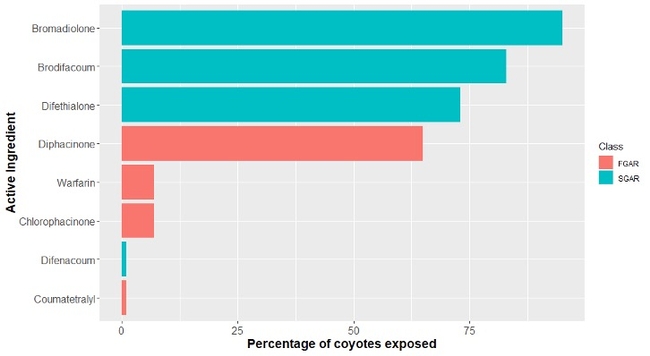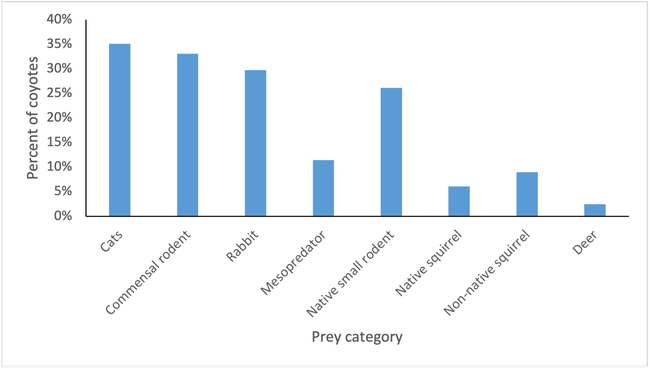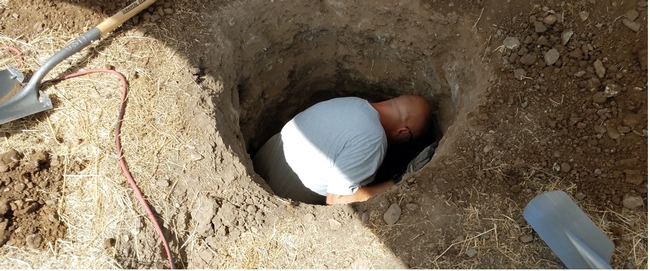
Where is rodenticide exposure in wildlife coming from? Is it from use by residents or farmers? Applications by marijuana growers? Or from applications by qualified and trained structural pest control professionals? These questions are being asked by state legislators and regulators, special interest groups, and state pest associations across the country.
However, even though we don't fully know where all the exposure is coming from, action is already being taken to restrict the use of rodenticides in urban areas. In 2020, California legislators placed a moratorium on almost all uses of second-generation anticoagulant rodenticide. And local jurisdictions have also added restrictions to rodenticide use. For example, in southern California, the California Coastal Commission granted special approval to the city of Malibu to ban all uses of rodenticides.
What's being done?
Researchers at the University of California Division of Agriculture and Natural Resources (UC ANR) South Coast Research and Extension Center in Irvine have been examining some of these questions over the past seven years. UC ANR's Human-Wildlife Interactions Advisor Dr. Niamh Quinn and colleagues have looked at urban coyotes' exposure to anticoagulant rodenticides (ARs), which active ingredients they were exposed to, and the amounts of AR exposure.
Almost all coyotes examined had been exposed to at least one anticoagulant rodenticide and usually, multiple active ingredients (Table 1). Some were exposed to low amounts of ARs and some were exposed to very high levels. However, less than 1% of the coyotes examined had died from AR exposure. Recent studies on the sublethal effects of exposure have not shown any clear links between AR exposure and sublethal impacts (such as reduced body condition or parasite load). There is also no link between AR exposure and mange in coyotes in urban southern California.
Do coyotes eat rats?
The diet of the urban coyote in southern California was questioned, specifically “Do they eat roof rats?” and “If they don't eat roof rats, how else could they be getting exposed to anticoagulant rodenticides?” It turns out that coyotes do eat rats (Figure 1). They eat a variety of other things too, but rats are among their preferred mammalian prey items, along with rabbits and domestic cats (Table 2).
In one of the first studies of its kind, we examined which animals were actually visiting rodenticide bait stations. We were surprised to find that in southern California, it is mostly roof rats, rather than nontarget animals. This was confirmed in another study sponsored by BASF. In southern California, less than 1% of mammals entering bait stations in urban area were nontarget wildlife. This is good news!
However, if pest management professionals are using anticoagulant rodenticide and are exposing just roof rats, and coyotes are eating said rats, does this mean that legal applications are responsible for the urban coyote AR exposure?
Another interesting finding from these studies concerned how rats use bait stations. With non-toxic baits used during this study, we photographed rats entering only 59–70% of the bait stations, suggesting that roof rats may be reluctant to enter bait stations, even when no rodenticide was present. Even in yards where rats eventually entered stations, it took 7 to 8 days for them to first encounter the bait directly.
What does this mean?
Because the first mortalities from anticoagulant rodenticide might not occur for several more days, pest management professionals should be prepared to communicate these possible delays to their customers. This will prevent customers from becoming impatient and taking more drastic (and potentially illegal) measures when results are not immediate.
Tracing applications of anticoagulant rodenticides
The ability to trace the applications of anticoagulant rodenticides has been lacking, but we may have developed a method to trace AR movement. We have created a bait that can be traced up multiple levels of the food chain. Therefore, we will be able to finally trace the rodenticide bait from its point of application to see if a legal application of anticoagulant rodenticide ends up in multiple levels of the urban and suburban food chain.
Two separate studies were conducted to see where animals exposed to anticoagulant rodenticides die and what scavenges them. One was conducted by Dr. Roger Baldwin in an agricultural setting and one by Dr. Paul Stapp from Cal State Fullerton in the suburban environment. Dr. Baldwin discovered that ground squirrels exposed to first generation anticoagulant rodenticides were mostly dying below ground (Figure 2). Dr. Stapp discovered that rats left in backyards are scavenged on by all sorts of animals including crows, skunks, opossums, and domestic cats. After 7 days, almost all (65%) of the carcasses had been either partially removed or removed completely.
Do coyotes and other large predators also scavenge rats? In research conducted in Europe, 92% of dead rats were inaccessible to large predators and scavengers. It is thought that rats killed by brodifacoum in and around farm buildings don't seem to present a major secondary exposure risk to large vertebrates.
What is next for rodenticide research?
We are developing methods to monitor rodenticide exposure in wildlife in a more meaningful way. The Quinn Lab and other institutions are working on methods to sample for rodenticides in live mammals and birds of prey with the aim of being able to detect any population -level impacts of rodenticide exposure. These methods will provide a mechanism by which rodenticide exposure can be monitored in live populations.
There is a huge need for data-driven mitigation measures for rodenticide exposure in California. We have been testing the efficacy of different management practices. We are testing trapping only, second-generation anticoagulant only, and a mix of both trapping and anticoagulant rodenticide. Using a combination of tracking rodents by collaring them and measuring how long it takes them to die, and by using tracking tunnels, we are measuring how quickly and how effectively these management options manage roof rat populations in southern California.
A mutation associated with second-generation anticoagulant rodenticide resistance, the Y25F mutation, has been found in roof rats in California. We don't know what this discovery means for rats in California. We need to explore more and find out to what extent they are resistant. Resistance management is essential for prolonging the life of all pesticide active ingredients.
Rodent management is complex, time consuming and we are tackling the unknown. We know more about polar bears than we do about commensal rodents. We need to know more to address inadequacies in rodent management. To reduce the amount of secondary AR exposure in the environment, it is necessary to ensure that rodent populations do not rebound and that they are not continually being exposed to active ingredients that can bioaccumulate in the food chain. If predators continue to eat commensal rodents, it is important to figure out ways to reduce the number of them that are exposed to rodenticides.
What does the future of rodent management look like?
It is important to continue work with municipal managers, schools, and customers to ensure that they do their parts. Exclusion and sanitation must be important components of a rodent management plan, especially as there continue to be restrictions on rodent management tools. In some countries, the sale and use of glue boards to catch rodents are prohibited. Certain snap traps have failed rigorous testing in some countries and are considered to cause unacceptable pain and suffering so are prohibited for use. It is important that pest management professionals use tools according to labels and trapping specifications. PMPs must rely on safe and effective methods.
Managing rodent populations such as roof rats is increasingly difficult since there are expanding restrictions on management tools and a dearth of applied research on commensal rodents. To solve these issues, we must find more sustainable and effective management practices.
Our funders and collaborators for these research projects were Cal State Fullerton, the Pest Management Foundation, the California Structural Pest Control Board, the National Wildlife Research Center, California Department of Pesticide Regulation, California Department of Food and Agriculture, and the Anticoagulant Taskforce.
[Originally featured in the Summer 2022 edition of the Green Bulletin Newsletter for structural and landscape pest professionals.]


